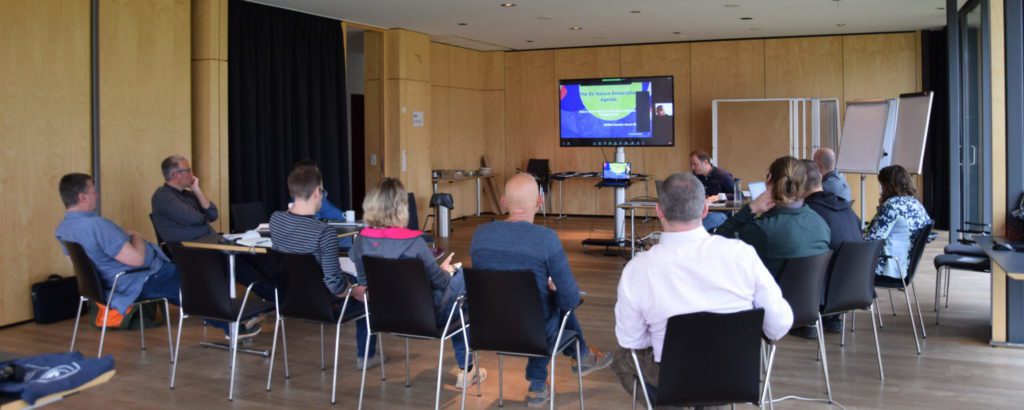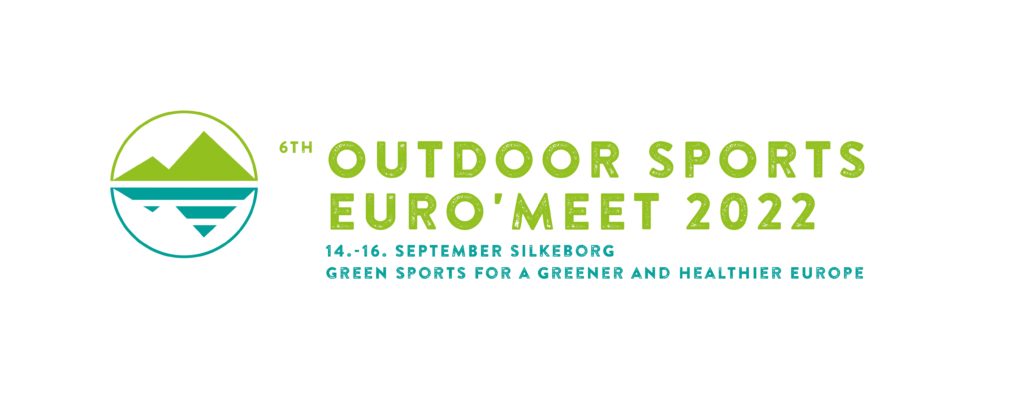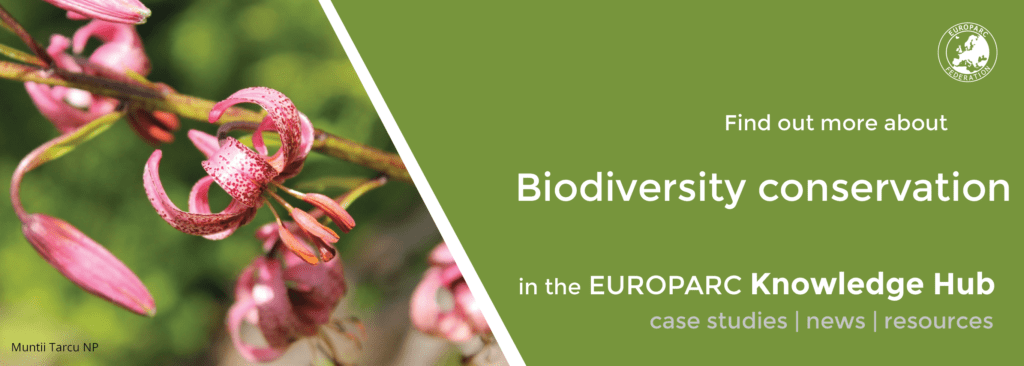How Protected Areas can contribute to the new EU Nature Restoration targets
On June 22, 2022, the European Commission proposed a new Nature Restoration Law, an essential part of the EU Green Deal and Biodiversity Strategy for 2030.
The EU Nature Restoration law
The Commission set multiple targets to restore degraded ecosystems such as wetlands, rivers, forests, grasslands, marine ecosystems, and the species they host. This proposal combines both general and specific objectives, ensuring long-term nature recovery and specific implementation measures.
By 2030, these measures should extend to at least 20% of the land and water areas in the EU, and by 2050, they should apply to all ecosystems that require restoration.
Today, for the first time ever, we are proposing a law that would require all Member States to restore nature. We need to repair the 80% of our nature that’s in bad shape, and bring nature back to our cities, towns, forests, agricultural land, seas, lakes, and rivers – the nature that our citizens want and need.
Executive Vice-President Frans Timmermans, statement from press release of the new proposal.
Why do we need this?
Unfortunately, 81% of habitats in Europe are in a bad state despite the Birds and Habitats Directives having restoration goals. A review of the Biodiversity Strategy for 2020 highlighted the voluntary nature of these goals as the core problem and suggested a legally binding tool: The EU Nature Restoration Law
This is the first new environmental legislation since 2015 and will be relevant for areas inside and outside Natura 2000 protected areas, for urban green spaces and for agricultural landscapes. Once the regulation is approved, the work can start immediately and the law can be enforced without having to wait for national laws to be laid down first (as would be the case for a Directive).
Read the full proposal here or check out the EU Factsheet here.
What are the key targets?
- restore habitats and species protected by the EU nature legislation
- reverse the decline of pollinators by 2030
- no net loss of green urban spaces by 2030 and a minimum of 10% tree canopy cover in European cities
- improved biodiversity on farmlands
- restore drained peatlands
- healthier forests with improved biodiversity
- at least 25.000 km of free-flowing rivers by 2030
- restore seagrasses and sea floors
What are the next steps?
The very next step is that it needs to be approved by the Council and the EU Parliament. Only then is it adopted.
Each Member State is required to submit a National Restoration Plan to the Commission two years after the adoption and then monitor their progress. The first EU report has already been set for June 2031.
You can find more information on timelines and the implementation process here.
How can Protected Areas contribute?
The first step in halting and reversing biodiversity loss is to stop any downward trends. The second step is to restore what was lost. Protected Areas are already doing this! They will be examples of the gold standard of a “good ecological status” for many habitat types.
Protected Areas are also leading the way with restoration efforts and can share their journey, best practices and expertise. This was what the 11 experts from across Europe who gathered for the EUROPARC 2022 Siggen Seminar discussed earlier this year.
Read more about it here or check out the outcomes presentation here.
Additionally, creating new Protected Areas is a tool for restoration. Once destructive activities are restricted, an ecosystem can recover by itself. This passive restoration through Protected Areas will be a key tool for the restoration of marine areas.
What happens when areas are restored?
The EU Nature Restoration Law should feed into other strategies on sustainable development, renewable energy and conservation. Once an area is restored, or sometime as it is being restored, it can be used for one or more of the following:
- a new Protected Area to achieve the goal of 30% of land and sea protected by 2030
- new wind and solar energy projects to reduce reliance on fossil fuels
- sustainable agriculture (e.g. a rewetted peatland can be used to grow cranberries)
Estimates say that for every 1€ invested in nature restoration, we receive 8€ of benefits. These will be not just ecosystem services like clean air and water but also opportunities for local communities such as new jobs in sustainable businesses or nature protection.
EUROPARC will continue to follow the process of the nature restoration law – so watch this space. Once it is adopted, it is important the during the creation of the National Restoration Plan, policy makers consult with Protected Areas and profit off the wealth of experience they have to offer. It is during this time, that nature conservation professionals and Protected Area managers will need to emphasise how essential nature restoration is to climate change adaptation, biodiversity and human health, and how important it is to bring the whole community onboard for successful implementation.
Interested in nature restoration?
Check out our knowledge hub here.
Nature Restoration in Europe – the Role of Protected Areas
All participants of the Siggen Seminar 2022
Once a year, the EUROPARC Federation, thanks to the generous support of the Alfred Toepfer Stiftung, offers members a free seminar. This year the ‘Siggen Seminar’ focussed on Nature Restoration.
Why restore nature?
As clearly stated by the EU in the Green Deal and the Biodiversity Strategy to 2030, protecting the nature we have will not be enough to reverse biodiversity loss. A complementary ambitious effort is now needed on nature restoration.
Restoring ecosystems all over Europe will help to increase resilience and connectivity of ecosystems, mitigate and adapt to climate change and prevent and reduce the impacts of natural disasters. For this, the European Commission is developing a new dedicated legislation, and the Bern Convention has recently approved targets for the restoration of natural ecosystems.
What’s the role of Protected Areas?
From the 28th till the 30th of March, 11 experts from all over Europe came together to discuss the role Protected Areas have to play in this process.
The policy perspective was provided by Angelika Rubin of the Nature Unit of the European Commission’s DG Environment. Sadly, the EC’s proposal for a legislative framework for Member States regarding Nature Restoration has been delayed. It will hopefully be published this month (June 2022). Nonetheless, from her intervention, it became clear that special efforts will need to be put into updating the monitoring system, as well as large-scale restoration efforts.
Protected Areas are essential for restoring what was lost and protecting what was restored.
You can find Angelika’s presentation, as well as all others at the bottom of the page.
The seminar

For two extensive days participants worked in teams to find answers to the following questions:
- What are the benefits of nature restoration for communities?
- How to implement nature restoration (from a governance perspective)?
- What are the key roles of Protected Areas (managers) in nature restoration?
- How can restoration projects be set up?
There was a balance of presentations held and prepared by the participants, as well as group work. Of course, the Seminar also facilitated networking and informal exchange.
The work of participants has resulted in a PowerPoint presentation that gives the answers to the above questions and also details what the opportunities are for Protected Areas concerning nature restoration. It should serve as a resource for Protected Area managers to underline the key role their Parks have to play in restoration efforts.
Know your worth
One thing that was underlined during the seminar, is that Protected Areas are not just “another interest group” when it comes to nature restoration, they are the experts! On that basis, the Siggen Seminar participants identified the following key roles for Protected Areas:
- Protected Area management teams are experienced and skilled ecosystems caretakers. They have the know-how to support, lead and inspire restoration projects. They have the ability and governance tools to plan, implement and monitor them to ensure success.
- Protected Areas offer high quality reservoirs of diverse species and functional habitats and ecosystems. They can serve as a model and a source to be connected to restored areas.
- Protected Areas are, or can be, living labs for nature restoration projects. Their features and structures are well suited to incubate pilot projects, demonstrate what is possible to achieve and share learnings and successes.
- Being a connection between people and nature in living land- & seascapes, Protected Areas can help communicate and collaborate with communities to foster ownership, pride, and involvement in nature restoration projects at a local level. They can help communities thrive, be rewarded and celebrate success!
- Bring in resources and funds for restoration to drive action. Protected Areas can be a bridge between local, regional, and global activities and networks and help secure both funding, and implementation.
You can find the PowerPoint presentation with all the outcomes here.
Presentations
All presentations held by our experts and participants can be found here:
Olivier de Sadeleer – Introduction to the Siggen Seminar
Angelika Rubin – Nature Restoration at EU Level
Ben Ross – Nature Restoration in Scotland
Elliott Lorimer – Restoration at Forest of Bowland
John van den Berg – River Restoration in the Netherlands
Santtu Kareksela – National scale prioritization and spatial planning in Finland
Outdoor Sports Euro’Meet conference 2022
How can we maximise the power of outdoor sports to make our lives and societies ever greener and healthier? This is the main theme for the 6th edition of the Outdoor Sports Euro’Meet conference.
A key event for the sector
The Outdoor sports Euro’meet is the strategic outdoor sports event and brings together key stakeholders committed to outdoor sports sustainable development. The Euro’meet provides a unique and engaging conference format that encourages interaction, networking and high-quality knowledge sharing. This event brings together outdoor sports experts, decision makers, outdoor sports federation representatives, practitioners researchers from the outdoor sports sector, national agencies, academic institutions, local authorities, not for profit organisations and businesses from all over Europe for experiential learning, development and sharing.
Three days, three topics: one goal
It’s now more important than ever to become proactively involved in the transition to a greener outdoor sports sector. Therefore the Outdoor Sports Euro’Meet 2022 conference will address three essential topics, within the theme “Green Sports for a Greener and Healthier Europe”, that will provide opportunities for in depth discussions and inspiration.
Balancing access, activities, and protection: We must not take nature for granted. At the Outdoor Sports Euro’Meet 2022 we will focus on how to develop and carry out projects in Protected Natural Areas and reduce our climate impact. We will also raise the question on how to go beyond sustainability to promote restoration of nature and biodiversity in our practices.
Be active, be healthy, be outdoors: We know, that the outdoors and outdoor sports are effective tools in health promotion and disease prevention, but which activities do actually work best? How do we organize our activities and communicate effectively to target groups that are not “the usual suspects”? The conference will create discussion points and share solutions to these key aspects.
Welfare and the power of the outdoor: There are many opportunities for integrating nature and outdoor activities in existing public welfare – in existing schools, daycare, health care and many more aspects of our societies. How do we move on from goals, policies and strategies to actual projects and activities? How do we involve our communities in this transformation of public welfare? The Outdoor Sports Euro’Meet 2022 will bring a focus on how we can take action on these important questions.
Propose a workshop and showcase your project
This conference will be based on active participation. This is why we encourage participants to propose engaging workshops, or to showcase their own practice-based or research project results that could inspire other participants to turn knowledge and experience into action. We are also seeking your nomination(s) of outstanding projects, initiatives which have recently demonstrated exceptional achievement and commitment to promoting the development of outdoor sports and be aligned with the shared vision of the European Network of Outdoor Sports Charter.
Secure your ticket* now to join the most important event for the outdoor sports sector!
*Special discount applies on conference fee for ENOS Members.
Biodiversity Day 2022: Building a shared future for all life
The International Day for Biological Diversity is celebrated every year on May 22nd to increase understanding and awareness of biodiversity issues.
Biodiversity is a term used to describe the enormous variety of life on Earth. It refers to every living thing, including plants, bacteria, animals, and humans. It is essential for the health and balance of our planet and may be the answer to many sustainability challenges. From nature-based solutions to climate change, health issues, food and water security, and sustainable livelihoods, biodiversity is the foundation upon which we can build back a better, stronger and shared future for everyone.
The slogan announced by the Secretariat of the Convention on Biological Diversity (CBD) for Biodiversity Day 2022 is:
Building a shared future for all life
Biodiversity Day 2022
As we continue to build on the post-2020 global biodiversity framework to be adopted at the upcoming UN Biodiversity Conference (COP15), let’s take a moment to remind ourselves of the importance of biodiversity and celebrate it all together!
Activities
Explore the Convention of Biological Diversity’s website and choose an activity to follow, an event to attend, or simply get inspired by all the opportunities and proposals out there:
- 22 Actions for Biodiversity
- Organize your event or activity!
- Download and use all materials and logos (you can also customize them just as we did!)
To conserve biological diversity is to protect the Earth, our shared home and to build a shared future for all life.
This is the message from H.E. Mr. Huang Runqiu, Minister of Ecology and Environment, President of #COP15. You can find many more messages on solidarity and highlighting the importance of addressing the biodiversity crisis on this page.
Join the Global Biodiversity Festival
The Global Biodiversity Festival is a virtual global event for anyone! The goal is to raise awareness on biodiversity loss. On 20-22 May, they’ll share the diverse stories and challenges and successes of scientists, explorers, conservationists, film-makers and policy makers on the front lines of the race to save the incredible variety of life on our planet, us included.
Are you ready for 80 hours of live broadcast with over 160 speakers from all 7 continents and 60+ countries? The event is open and free to join for anyone from anywhere, but registration is required to join the talks and events. Find more information and register here!
EUROPARC and biodiversity conservation
Biodiversity conservation is one of the main goals of our beautiful Protected Areas. As EUROPARC, we celebrate and promote efficient conservation policies, knowledge-sharing and good management practices that respect or enhance biodiversity. We strongly believe it is our Parks and Protected Areas that hold the solutions to biodiversity and climate crises. This is why EUROPARC and other leading organisations in charge of some of the largest tracts of Protected Landscapes and Marine Environments across the world have signed a joint statement at the 26th UN Climate Change Conference of the Parties (COP26).
You can read the statement here.

